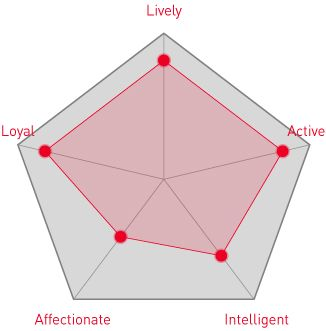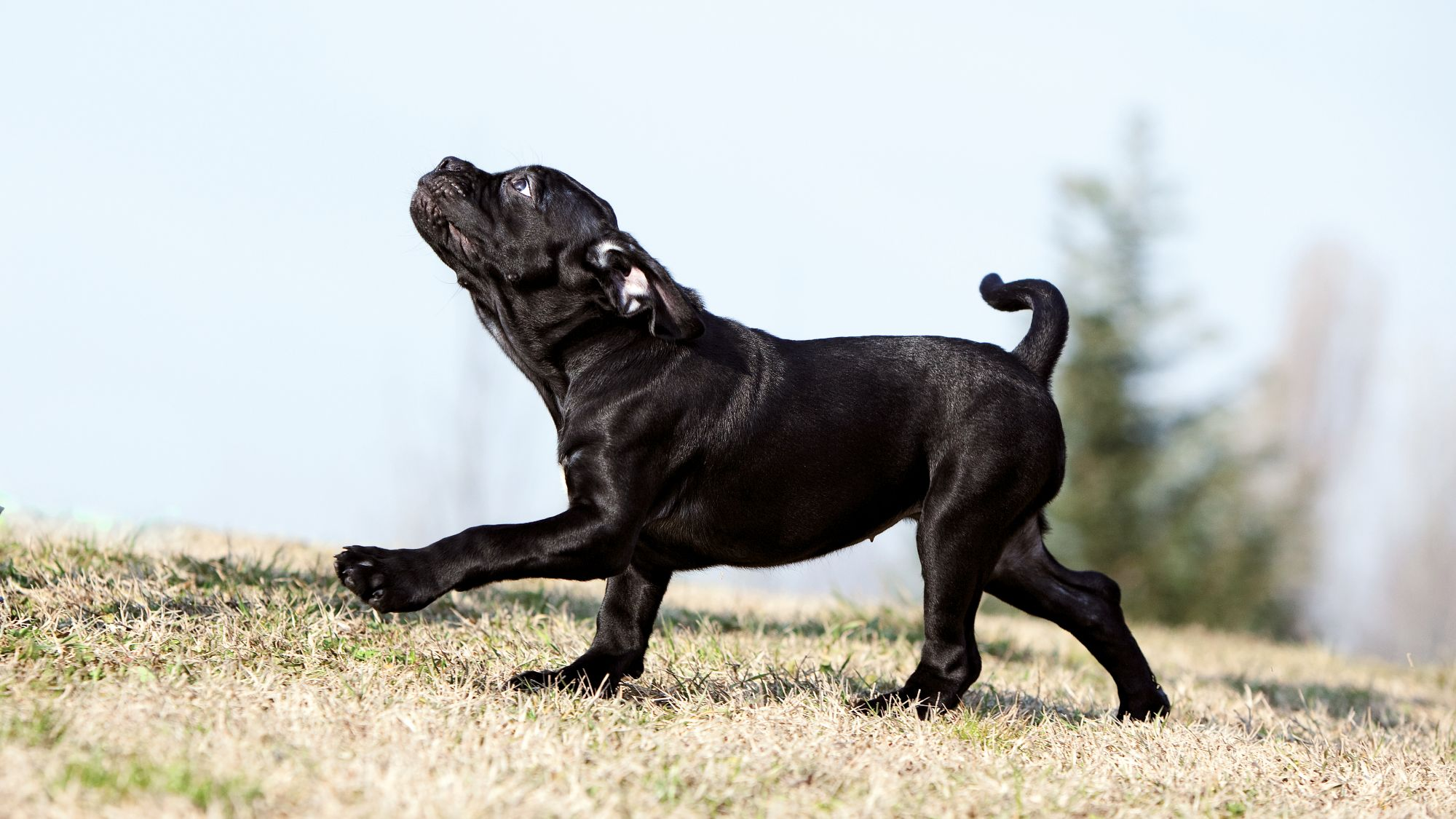
Let's talk Cane Corsos
A majestic breed if there ever was one, the Cane Corso is a faithful companion and fearless protector. Always eager and devoted, the breed’s incredibly muscular body combined with a keen temperament makes them a superb watchdog—their name translates roughly from Latin as ‘bodyguard dog.’ And yes, they will always love you. Their nonchalant gaze transmits a cool confidence but make no mistake: Beneath that tough exterior lies a sweet sentimental sort.Official name: Cane Corso
Other names: Cane Corso Italiano, Italian Court Dog
Origins: Italy

| Drooling tendencies |
|
Warm weather? | |
| Shedding level | Suited to apartment living? |  |
|
| Energy level (high, low, medium) *: | High | Family pet? * |
|
| Compatibility with other pets |  |
Can stay alone?* | 
|
* We advise against leaving pets alone for long stretches. Companionship can prevent emotional distress and destructive behaviour. Speak to your veterinarian for recommendations.
Every pet is different, even within a breed; this snapshot of this breed’s specifics should be taken as an indication.
For a happy, healthy and well-behaved pet, we recommend educating and socialising your pet as well as covering their basic welfare, social and behavioural needs.
Pets should never be left unsupervised with a child.
All domestic pets are sociable and prefer company. However, they can be taught to cope with solitude from an early age. Seek the advice of your veterinarian or trainer to help you do this.


| Baby age: | Birth to 2 months |
| Puppy age: | 2 to 8 months |
| Adult age: | 8 to 2 years |
| Mature age: | 2 to 5 years |
| Senior age: | From 5 years |

1/7
Get to know the Cane Corso
All you need to know about the breed
Despite their slightly intimidating presence, the Cane Corso is gentle to the bone. A hugely loyal companion who is incredibly eager to please, they are a mastiff type of breed—characterised by a substantial body, large feet, bulky head, and a brachycephalic front, which means a shortened muzzle and nose.
Developed for big-game sport and used to being assertive, Corsi – as they’re known in the plural – are quite intelligent, so will need a serious, assertive owner. Showing the breed who is in charge from early on is important. Large guardian dogs like the Cane Corso require socialisation with family and friends to achieve the most even temperament.
The breed is one to compete in tracking, agility, obedience, and protection sport. The Cane Corso’s admirable traits are plenty, and the need for exercise is chief among them. Two walks a day at minimum are best, a run even better if you are so inclined. This is not a dog that sits still! The breed thrives in a home with land or a large yard.
As wonderful a family dog as the Cane Corso is, they are not one to take to others so quickly. The dog is very devoted to their owners and hesitates when bonding with others. Get them used to family and friends early on to bring out the best traits of your Cane Corso.

2/7
2 facts about Cane Corsos
1. Keep mealtime calm
Large breeds like the Cane Corso can have a condition called gastric dilatation and volvulus – GDV – or most commonly called bloat. The condition, often abrupt, can happen after a too-quick meal where the stomach turns and fills with gas. Seek medical attention right away if it does occur as it is treatable but can be fatal. Any swelling, restlessness, or sudden discomfort are signs of GDV. Regular vet visits and careful feeding are the best preventative.
2. Lives to work
A dog like the Cane Corso needs to be occupied during waking hours. They benefit tremendously from taking on needed tasks around the house – if in a more domestic situation – or guarding property or livestock if in a farming or agricultural one, as guardianship is second-nature to them. This is one dog who is highly loyal to their owners and to the homefront.
History of the breed
The stunning Cane Corso has long been seen as a dignified breed, with roots in their home country of Italy enough to cement their sophistication. The Cane Corso’s history there dates to ancient Rome. They are a Molosus subcategory of working breed, thought to descend from the ancient Greek Molossi tribe which bred powerful, large mastiff-type dogs. When the Roman Empire reigned supreme over Greece, native Italians brought the dogs home to further develop them.
The Cane Corso’s ancestors – thought to be even bigger and fearless – were used mainly for battle. As Italy’s wartime endeavours faded, the Cane Corso was utilised over centuries to guard farms and for sport. With the onset of industrialisation, the Corsi’s numbers dwindled and by the mid-twentieth century, they were all but extinct.
Thanks to a group of enthusiastic fanciers, the Cane Corso breed survived, hitting U.S. shores in 1988 and being recognised by the AKC in 2010.

4/7
From head to tail
Physical characteristics of Cane Corsos
1. Ears
Flöt en ekki þung eyru hanga niður beggja vegna höfuðsins
2. Feldur
Stuttur, þéttur feldur yfir vatnsheldum undirfeldi
3. Fur
Feldurinn getur verið svartur, súkkulaðibrúnn eða gulur, allt frá rjómagulum upp í rauðleitan
4. Skott
Langt skottið er ofarlega og er stöðugt á iði, stundum iðar jafnvel allur líkaminn.
5. Leggir og hryggjarsúla
Hlurfallslega vel vaxinn og gott jafnvægi á milli leggja og hryggjarsúlu.

5/7
Things to look out for
From specific breed traits to a general health overview, here are some interesting facts about your Cane Corso

6/7
Caring for your Cane Corso
Grooming, training and exercise tips
Cane Corso grooming is simple given their short single coat; occasional brushing will keep them at their best. Cleaning their ears and trimming nails often is of course in the dog’s best interest. The Cane Corso needs lots of exercise. This is a powerful and strong dog bred for guarding so will flourish with constant challenges. Agility, tracking, and obedience training are all right up their alley—even dock diving! To bring out the best in your Cane Corso, thorough and consistent training is required. This is a willful breed with a strong mind and stronger spirit who thrives best when helped along by an experienced master. Make sure to maintain the upper hand though while providing the security the Cane Corso requires.7/7
All about Cane Corsos
The Cane Corso dog is a physically powerful breed. New owners should be experienced with dog ownership as well as handling a larger animal. Proper training is essential for bringing out the best in the Cane Corso breed.
Leave it to the Italians to invent another noble and sophisticated product, this time in the form of a canine. Although cross-bred over the years to develop their better characteristics, there are no two breeds that the Cane Corso draws upon. The dog hails originally from ancient Rome, used for war and security.
Read more on this topic


How to adopt a dog

Things to consider before getting a dog
Sources
1 - Veterinary Centers of America https://vcahospitals.com/
2 - Royal Canin Dog Encyclopaedia. Ed 2010 and 2020
3 - Banfield Pet Hospital https://www.banfield.com/
4 - Royal Canin BHN Product Book
5 - American Kennel Club https://www.akc.org/